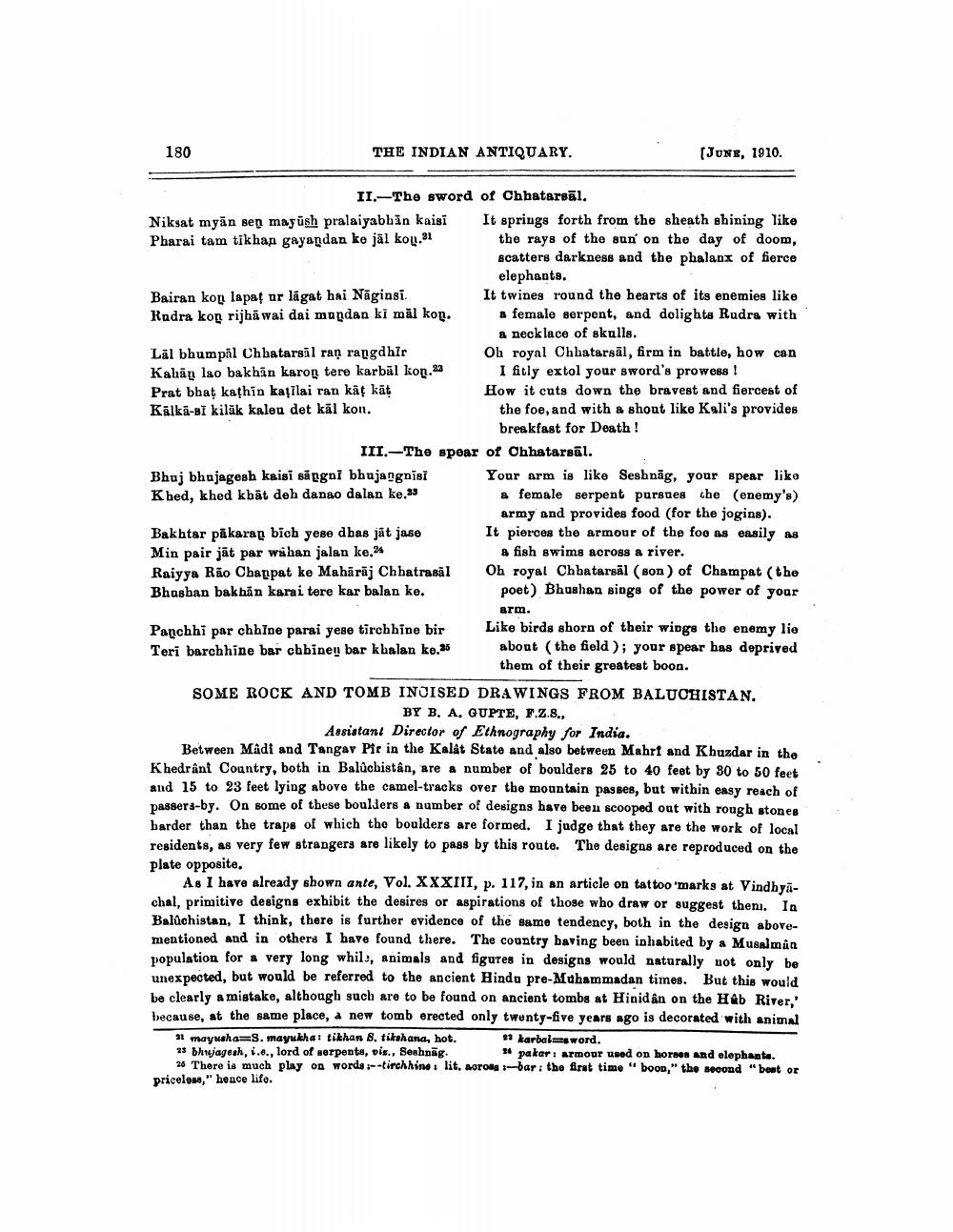________________
180
THE INDIAN ANTIQUARY.
(June, 1910.
II.-The sword of Chhatarsāl. Niksat myān sen mayūsh pralaiyabhän kaisi It springs forth from the sheath shining like Pharai tam tikhan gayandan ko jäl kov.21 the rays of the sun' on the day of doom,
scatters darkness and the phalanx of fierce
elephants. Bairan kon lapat ar lāgat hai Näginsi.
It twines round the hearts of its enemies like Rudra kop rijhā wai dai mapdan ki mäl kon. a female serpent, and delighta Rudra with
a necklace of skulls. Läl bhumpal Chbatarsil raņ rapgdhir
Oh royal Chhatarsāl, firm in battle, how can Kahap lao bakhăn karon tere karbal kop.23 I fitly extol your sword's prowess! Prat bhat kațhin kațilai ran kät kāt
How it cuts down the bravest and fiercest of Kálkā-Bi kiläk kaleu det kāl kon.
the foe, and with a shout like Kali's provides
breakfast for Death !
III.-The spear of Chhatarsāl. Bhuj bhujagesh kaisi så pgoi bhujangnisi Your arm is like Seshnäg, your spear like K bed, khed kbāt deh danao dalan ke 33
a female serpent pursues che (enemy's)
army and provides food (for the jogins). Bakhtar păkaran bich yese dbas jāt jase It pierces the armour of the foo as easily as Min pair jāt par wahan jalan ke 24
a fish swims across a river. Raiyya Rão Chappat ke Mahārāj Chhatrasal Oh royal Chhatarsal (son) of Champat (the Bhushan bakhăn karai tere kar balan ke. poet) Bhushan sings of the power of your
arm. Panchhi par chhine parai yese tirchhine bir Like birds shorn of their wings the enemy lie Teri barchhine bar chbinen bar kbalan ke 26
about (the field ); your spear has deprived
them of their greatest boon. SOME ROCK AND TOMB INCISED DRAWINGS FROM BALUOHISTAN.
BY B. A. GUPTE, F.Z.8.,
Assistant Director of Ethnography for India. Between Madt and Tangay Pir in the Kalat State and also between Mahrt and Khuzdar in the Khedrânt Country, both in Baluchistan, are a number of boulders 25 to 40 feet by 80 to 50 feet and 15 to 23 feet lying above the camel-tracks over the mountain passes, but within easy reach of passera-by. On some of these boulders a number of designs have been scooped out with rough stones barder than the traps of which tho boulders are formed. I judge that they are the work of local residents, as very few strangers are likely to pass by this route. The designs are reproduced on the plate opposite,
As I have already shown ante, Vol. XXXIII, p. 117, in an article on tattoo 'marks at Vindhyāchal, primitive designs exhibit the desires or aspirations of those who draw or suggest then. In Baluchistan, I think, there is further evidence of the same tendency, both in the design abovementioned and in others I have found there. The country baving been inhabited by a Musalman population for a very long whild, animals and figures in designs would naturally not only be unexpected, but would be referred to the ancient Hindu pre-Muhammadan times. But this would be clearly a mistake, although such are to be found on ancient tombs at Hinidan on the H&b River.' because, at the same place, a new tomb erected only twenty-five years ago is decorated with animal
31 mayusha=s. mayukha: tikhan 8. tikahana, hot. 1 karbal=sword. 25 bhnajagesh, ..., lord of serpente, vis., Seshnäg.
pakar 1 armour used on horses and elephants. 26 There is much play on words --tinchhine lit, aoro -bar: the first time "boon," the second "bent or priceless," hence life.




